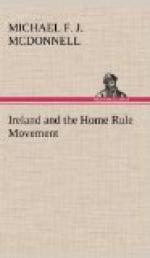On the establishment of the National Board all creeds and parties in Ireland were anxious that the basis of the system should be denominational, but in the teeth of this unanimity the principle adopted was that of united secular and separate religious instruction.
One would have thought that on the establishment of the National System the danger of its capture by the Protestant ascendancy, which was very obviously anxious to secure its control, would have ensured the insistence on safeguards for the rights of the weaker section of the community at a time when no longer held good that obiter dictum pronounced from the Bench in 1758, which was equally true for many years after, that “the law does not suppose a Papist to exist in the kingdom, nor can they breathe without the connivance of the Government.” On its formation the National Board included among its members Dr. Murray, the Catholic Archbishop of Dublin; Dr. Whately, the Protestant Archbishop of that city; and Dr. Carlisle, a Presbyterian Minister. No attempt was made to effect anything approaching a proportional representation of the creeds concerned, and the two Catholic members were outvoted by their five Protestant colleagues on the Board for the control of the education of the children of a population in which Catholics were to Protestants in the ratio of about 4 to 1.
The English Archbishop and the Scottish Presbyterian, in whom power was in this way placed, set themselves by their regulations to effect the Anglicising of the Irish children in the schools of the country. The use of the English language was enforced for the education of children, thousands of whom spoke Gaelic, and though this may possibly be justified on grounds of its greater use in the transactions of everyday life, the same cannot be said of the manner in which the history books employed were of a kind in which the subjection of Ireland by Elizabeth, James I., and William of Orange were extolled, as was also the defection from Rome of England in the sixteenth century.
Whately’s policy was avowedly to Anglicise the children in the schools, to effect the “consolidation,” as he called it, of Great Britain and Ireland, and in a reading book produced under his auspices occur the following lines, written with that aim in view:—“On the east of Ireland is England, where the Queen lives. Many people who live in Ireland were born in England, and we speak the same language, and are called one nation.”
From the reading-books as first published were expunged such verses as Campbell’s “Downfall of Roland” and Scott’s “Breathes There a Man with a Soul so Dead,” owing to their tendency, one must suppose, to suggest emotions other than those which it was deemed fitting to inculcate, and in their place was inserted a verse from the Archbishop’s own pen which is familiar to most Irishmen, but which is, I find, unknown to most Englishmen:—
“I thank the goodness and the grace
which on my birth have smiled,
And made me in these Christian days a
happy English child.”




